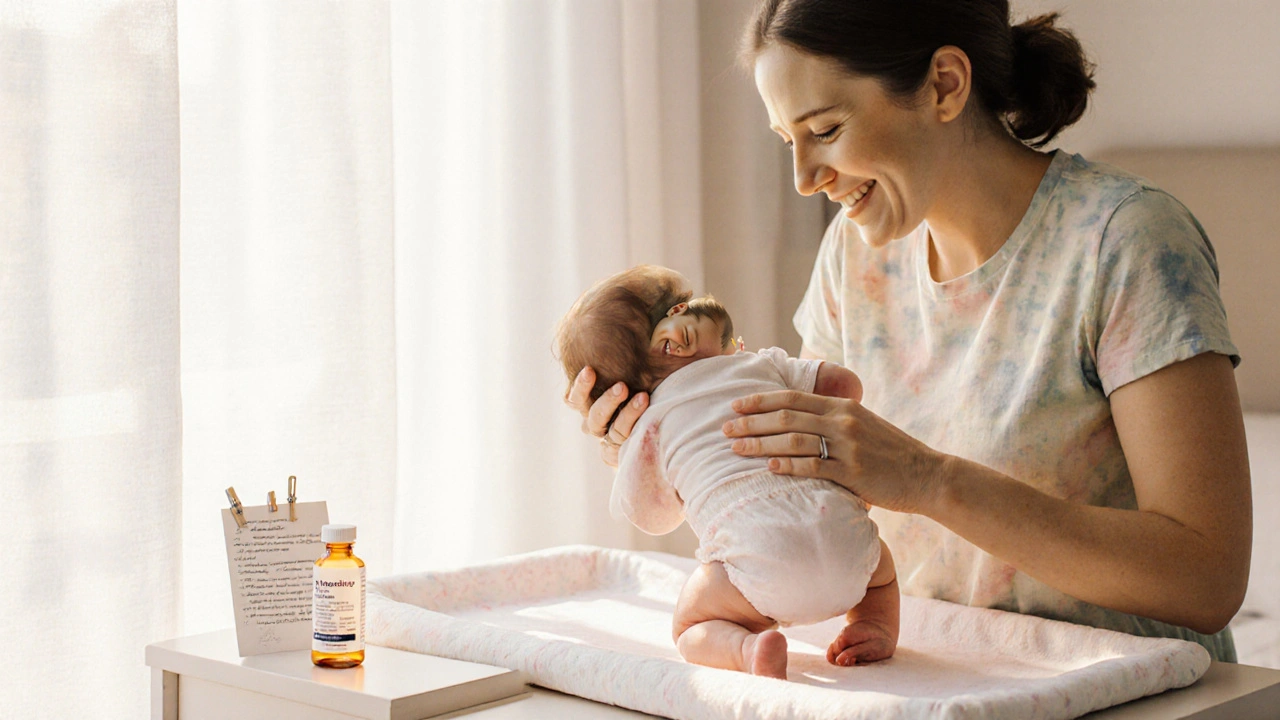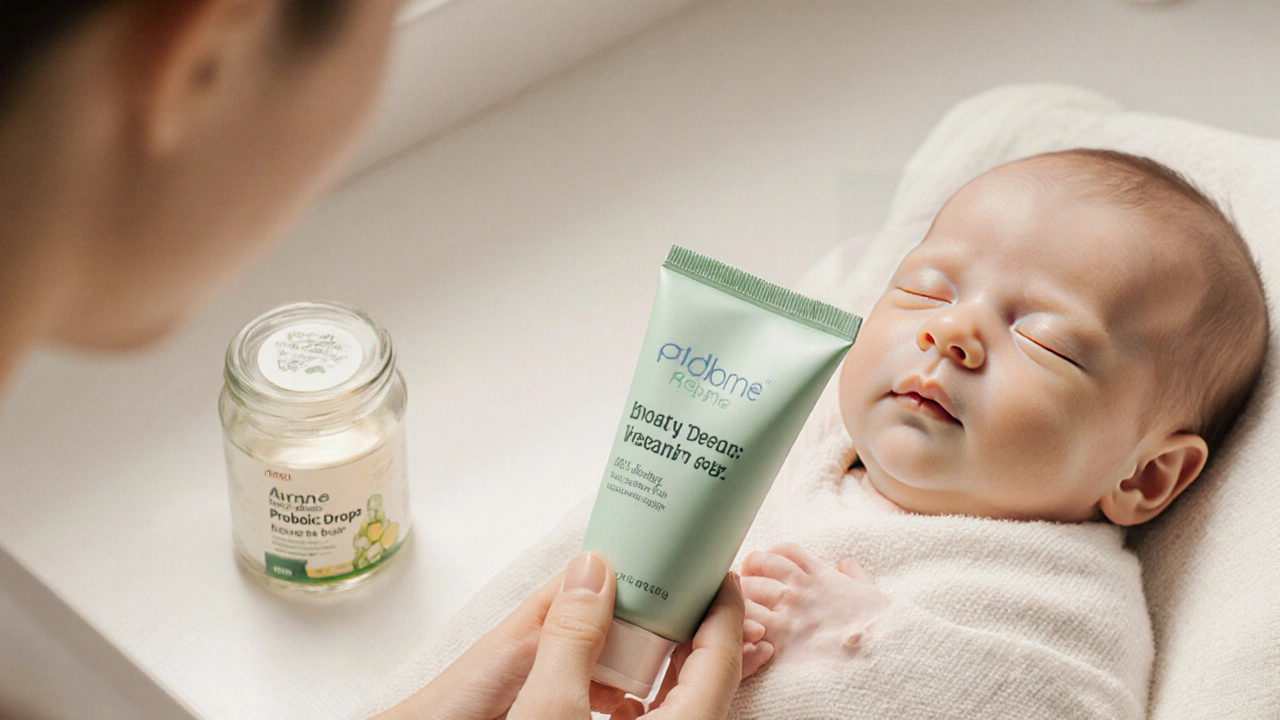How to Treat Diaper Rash Caused by Antibiotics - Fast Relief for Babies
 Sep, 27 2025
Sep, 27 2025
Antibiotic-associated diaper rash is a skin inflammation that appears in infants after a course of antibiotics, typically driven by an overgrowth of yeast or bacterial imbalance. When a baby’s gut flora is knocked off‑balance, moisture‑rich diapers become a breeding ground for irritation. Parents often wonder why a harmless‑looking rash suddenly flares after a prescription. This guide walks you through the why, the what‑to‑do, and the long‑term prevention plan.
What’s Really Happening Under the Diaper?
Antibiotics broad‑spectrum drugs target both harmful and beneficial bacteria in the gut. When the good bacteria disappear, Candida albicans a yeast normally kept in check by bacterial competition can multiply. The excess yeast releases enzymes that weaken the skin barrier, especially where the diaper traps heat and humidity.
Two other players join the mix: pH imbalance the acidic‑alkaline shift caused by bacterial die‑off and urine and moisture retention prolonged wetness that softens the epidermis. Together they create the textbook picture of a red, sometimes bubbly rash that spreads across the buttocks, thighs, and groin.
Spotting the Signs Early
- Bright red patches that may look shiny or wet.
- Small raised bumps (pustules) that suggest yeast overgrowth.
- Foul smell - a tell‑tale sign of bacterial involvement.
- Increased fussiness during diaper changes.
If you notice any of these within 48‑72hours of starting antibiotics, act fast. Early intervention prevents the rash from thickening into a painful, crusty lesion.
Immediate Care - What to Do Right Now
- Change diapers every 2‑3hours, keeping the area as dry as possible.
- Use lukewarm water and a soft cloth-skip scented wipes that can aggravate the skin.
- Pat, don’t rub, to avoid further micro‑abrasions.
- Apply a thin layer of a zinc oxide cream a mineral barrier that shields skin from moisture and irritants. Zinc oxide also has mild anti‑inflammatory properties.
- Leave the diaper off for 10‑15minutes after each change if possible; air‑drying dramatically cuts moisture.
These steps buy you time while you address the underlying gut imbalance.
Restoring Gut Balance With Probiotics
Because antibiotics are the root cause, fixing the microbiome is essential. A probiotic supplement live bacteria that repopulate the gut with friendly strains like Lactobacillus rhamnosus GG can be given once the baby finishes the antibiotic course or, under a pediatrician’s guidance, midway through.
Clinical guidelines from the New Zealand Paediatric Society (2023) show a 30‑40% reduction in recurrence of yeast‑related diaper rash when infants receive a daily probiotic dose of at least 10⁹CFU for two weeks after antibiotics.
For breast‑fed babies, continuing to nurse is already a natural probiotic boost. Formula‑fed infants can be switched to a prebiotic‑enhanced formula one that contains galacto‑oligosaccharides to feed good bacteria.

Choosing the Right Topical Treatment
| Product | Mechanism | Onset of Relief | Best For | Typical Cost (NZD) |
|---|---|---|---|---|
| Zinc Oxide Cream creates a breathable barrier | Barrier protection | 12‑24hrs | Mild to moderate irritation | 5‑8 |
| Clotrimazole Cream topical antifungal | Targets Candida | 6‑12hrs | Yeast‑predominant rash | 8‑12 |
| Probiotic Ointment delivers live cultures locally | Balances skin microbiome | 24‑48hrs | Recurrent rash after antibiotics | 10‑15 |
| Plain Petroleum Jelly occlusive moisturizer | Locks in moisture | Immediate | Very dry skin, not infected | 3‑5 |
For antibiotic‑related rashes, start with zinc oxide. If you see distinct white patches or the rash spreads despite barrier care, add a mild antifungal like clotrimazole. Probiotic ointments are a newer option; they work best when paired with oral probiotics.
When to Call a pediatrician a qualified child‑health professional
- Rash covers more than the diaper area (e.g., belly, chest).
- Fever over 38°C (100.4°F) accompanies the rash.
- Bleeding, pus, or skin that cracks open.
- Rash persists beyond 5‑7days despite proper care.
Doctors may prescribe a stronger antifungal or a short course of a topical steroid to calm severe inflammation. They’ll also check whether the antibiotic itself needs adjusting.
Long‑Term Prevention - Keeping the Rash at Bay
- Choose breathable diapers: cloth or low‑plastic, breathable‑core options lower moisture.
- Rotate diaper types every few weeks to avoid constant friction.
- Apply a thin layer of zinc oxide at every change, not just when a rash appears.
- Consider a daily probiotic during any future antibiotic courses.
- Limit scented lotions and wipes; they can alter skin pH.
These habits form a shield that makes future antibiotic courses less likely to trigger another flare.
Related Concepts You May Want to Explore
Understanding the broader ecosystem helps you stay ahead. Topics that naturally follow this article include:
- “How probiotics support infant gut health” - deep dive into strains and dosing.
- “Choosing the best diaper for sensitive skin” - a look at materials and ventilation.
- “Recognizing bacterial vs. yeast diaper rash” - visual guide for quick diagnosis.
- “When antibiotics are truly necessary for infants” - weighing risks and benefits.

Frequently Asked Questions
Can I use regular diaper cream while my baby is on antibiotics?
Yes, but choose one that contains zinc oxide or a mild antifungal. Avoid creams with strong fragrances or petroleum‑based ointments that can trap moisture when a yeast overgrowth is already in play.
How long does it take for a probiotic to show results?
Most infants see a noticeable reduction in redness within 3‑5days of daily probiotic use, but a full gut rebalance can take up to two weeks. Consistency is key.
Is it safe to give my baby an over‑the‑counter antifungal while breastfeeding?
Topical antifungals like clotrimazole are considered safe for nursing infants because they act locally and are absorbed minimally. Still, run it by your pediatrician first.
What signs indicate a bacterial infection rather than yeast?
Bacterial rashes often have a raw, beefy‑red look with possible pus or foul odor, and they may spread beyond the diaper area quickly. Yeast tends to produce bright red patches with small white or yellow pustules.
Should I stop the antibiotic if my baby gets a rash?
Never stop a prescribed course without consulting the doctor. The infection being treated may flare up, creating bigger health risks. Instead, manage the rash while completing the antibiotic.

liam martin
September 27, 2025 AT 22:06So there you have it, the tragic saga of a tiny human's bottom turning into a battlefield while the antibiotics wage war elsewhere. It feels oddly poetic, like the universe reminding us that every action has a ripple, even in the diaper realm. The poor little one isn’t just dealing with germs, but with the philosophical fallout of modern medicine. And we, the silent observers, can only offer a cream and a sigh. Still, the drama of a rash blooming after a prescription is oddly cinematic, isn’t it?
maya steele
September 30, 2025 AT 05:39Thank you for sharing this comprehensive guide; it covers the essential steps for parents dealing with antibiotic‑associated diaper rash. First, frequent diaper changes every two to three hours keep the area dry, which is the cornerstone of preventing moisture‑driven irritation. Second, using lukewarm water and soft cloths, rather than scented wipes, avoids further disruption of the skin barrier. Third, a thin layer of zinc oxide creates a breathable shield that not only protects but also offers mild anti‑inflammatory benefits. Fourth, allowing the skin to air‑dry for ten to fifteen minutes after each change dramatically reduces the environment that Candida thrives in.
On the systemic side, restoring gut flora with a probiotic supplement containing at least 10⁹ CFU of Lactobacillus rhamnosus GG has been shown to cut recurrence rates by up to forty percent. For breast‑fed infants, continued nursing naturally supplies beneficial microbes, while formula‑fed babies may benefit from prebiotic‑enhanced formulas rich in galacto‑oligosaccharides. If yeast overgrowth is evident, a mild topical antifungal such as clotrimazole can be introduced alongside the barrier cream. Should the rash persist beyond five to seven days, or if systemic symptoms like fever appear, seeking pediatric evaluation is prudent.
In summary, the combined approach of meticulous skin care, strategic use of barrier and antifungal agents, and proactive gut microbiome support offers the fastest relief and longest‑term prevention. Parents who implement these steps should see noticeable improvement within three to five days, with full resolution typically occurring within two weeks.
Raina Purnama
October 2, 2025 AT 13:12I appreciate the thoroughness of the earlier advice and would like to add a few clarifications for precision. When mentioning “zinc oxide,” it is helpful to specify that a minimum 15% concentration is generally recommended for optimal barrier function. Additionally, the term “probiotic” should be capitalised consistently when referring to commercial preparations. Finally, using the phrase “air‑dry” rather than “air dry” aligns with standard dermatological terminology.
April Yslava
October 4, 2025 AT 20:46Everyone forgets the big picture – the pharma giants push antibiotics like they’re candy, and the side‑effects are the collateral damage we clean up in our diapers. They don’t want you to question why a simple infection triggers a full‑blown rash, because that would expose the profit‑driven agenda. The only real solution is to limit unnecessary prescriptions and demand natural alternatives. Trust the old ways: herbal washes, breathable cloth, and a strict no‑chemical policy. If you keep buying into the corporate narrative, you’ll keep feeding the cycle of imbalance.
Daryl Foran
October 7, 2025 AT 04:19Honestly, this article feels like a sales pamphlet more than science. The tables are nice, but where are the primary sources? Also, the recommendation to use probiotics without a doctor’s note could backfire for kids with compromised immune systems. The tone is overly optimistic; we need more nuance about potential side effects of clotrimazole and zinc oxide, especially in babies with sensitive skin. A critical reader should demand meta‑analysis data before following these protocols.
Rebecca Bissett
October 9, 2025 AT 11:52Whoa-what a cascade of concerns! 😱🚨 It’s like you’ve opened a Pandora’s box of “what‑ifs” and now we’re stuck debating every molecule. But honestly, your caution is appreciated; nobody wants a hidden hazard lurking in a cute cream. Still, let’s not forget that the majority of pediatricians support these treatments when used properly. So maybe a balanced view? Keep the warnings, but also sprinkle in the success stories-parents love those! 🌟
Michael Dion
October 11, 2025 AT 19:26Looks fine.
Trina Smith
October 14, 2025 AT 02:59Indeed, simplicity often carries the deepest truth-like a calm lake reflecting the sky. 🌊 The journey through rash and relief mirrors the path of life: obstacles, adjustments, and eventual peace. Remember, each tiny step-changing a diaper, applying a cream-adds up to a larger narrative of caring and resilience. Keep the faith; the little ones sense our intention more than our words. ✨
Crystal Newgen
October 16, 2025 AT 10:32I’ve seen similar cases, and the routine of frequent changes plus a good barrier does the trick most of the time. Just stay consistent and monitor for any signs of infection.
Victoria Unikel
October 18, 2025 AT 18:06i tried the zinc cream and it helped but the rash still came back after a few days i think we need to keep it on longer maybe a night time only routine could work better
Lindsey Crowe
October 21, 2025 AT 01:39Oh wow, another groundbreaking insight-because “keep it on longer” totally solves everything. 🙄 Maybe next you’ll tell us to sprinkle glitter on the diaper for extra protection.
Bill Bolmeier
October 23, 2025 AT 09:12Hey everyone, great discussion! Remember that staying positive and proactive can make a huge difference. Keep those diapers fresh, give the skin a break, and don’t forget to celebrate the tiny victories-like a night with zero redness! Your baby’s comfort is worth every extra minute you spend caring.
Darius Reed
October 25, 2025 AT 16:46Totally agree! It’s like a canvass-every change paints a fresher picture. Just make sure you’re not over‑loading the poor lil’ one with too many potions at once, or you’ll end up with a rainbow of rashes. 😅 Keep it simple, keep it clean.
Karen Richardson
October 27, 2025 AT 23:19Correction: the phrase should read “over‑loading the poor little one,” not “over‑loading the poor lil’ one.” Additionally, “a rainbow of rashes” is an informal metaphor; in a clinical context, it would be better expressed as “multiple concurrent dermatological presentations.”